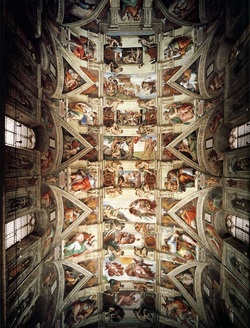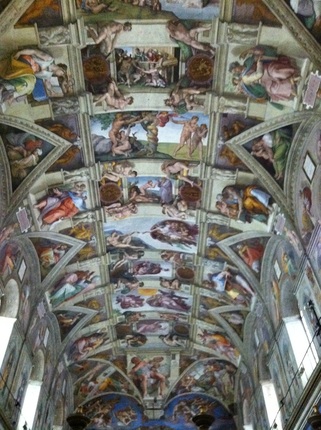
When Michelangelo got the commission he was an extremely skilled sculptor but initially lacked familiarity with the complex fresco technique.
He also had still in mind the project of the tomb of Julius II and it’s believed he wanted to delegate a large part of the pictorial execution to assistants.
Michelangelo got a Florentine friend that he trusted: his name was Francesco Granacci.
The 2 artists had studied together in Ghirlandaio workshop and in the garden of San Marco, that Michelangelo eventually entered thanks to Granacci's advise. Granacci never begun a very renewed painter.
He was unambitious, an easy living man and had a relaxed temper. In fact he specialized in less important decoration as theatrical scenery, banners for churches and knights, triumphal arches for parades.
Granacci’s lack of desire for glory was engaging for Michelangelo. Granacci easily acknowledged his supremacy, there was not artistic competition.
He entrusted Francesco Granacci to recruit the assistant he needed in Florence.

He also requested Granacci to be his second in command, aside from choosing the assistants he was to take care of other duties such controlling the work of the plasterers, purchasing the pigments etc.
Before starting painting Michelangelo had entrusted Pietro Rosselli the work of clearing the old plaster that remained of Sixtus IV starry sky, and lie down a new plaster – arriccio- on which the fresco could be worked.
Eventually the fresco technique requires two layers of plaster: a ticker one named arriccio, and the thinner one that is daily lied down to be painted until the surface of the wall is wet.
Rosselli and his team had built a scaffold following Michelangelo’s instructions: in less than three months the removal of the old fresco and the plastering of the vault have been completed: the arriccio was done and the ceiling was ready for painting.
Four assistants arrived form Florence in late spring 1508; they all came from the workshop of either Ghirlandaio or Cosimo Rosselli. Their name were Bastiano da Sangallo, Giuliano Bugiardini, Agnolo di Donnino and Jacopo del Tedesco.
The assistant’s salary was not very high, 20 ducats, and indicates that Michelangelo was not aiming to hire them for a long period.



